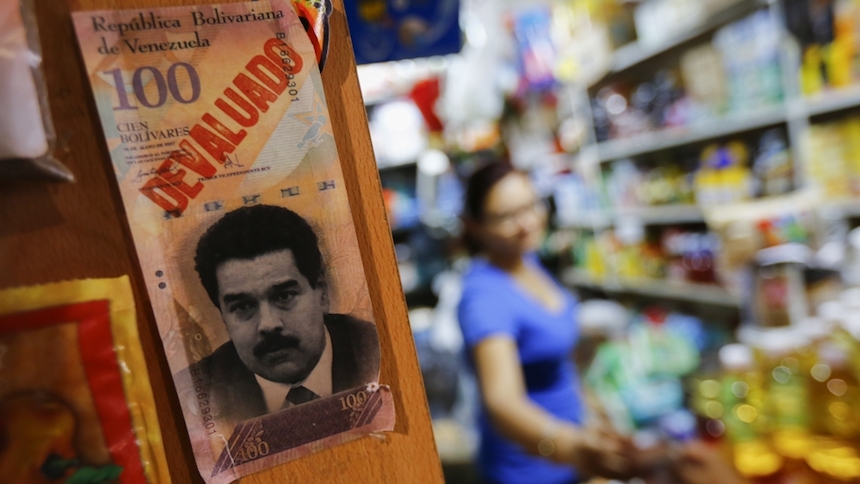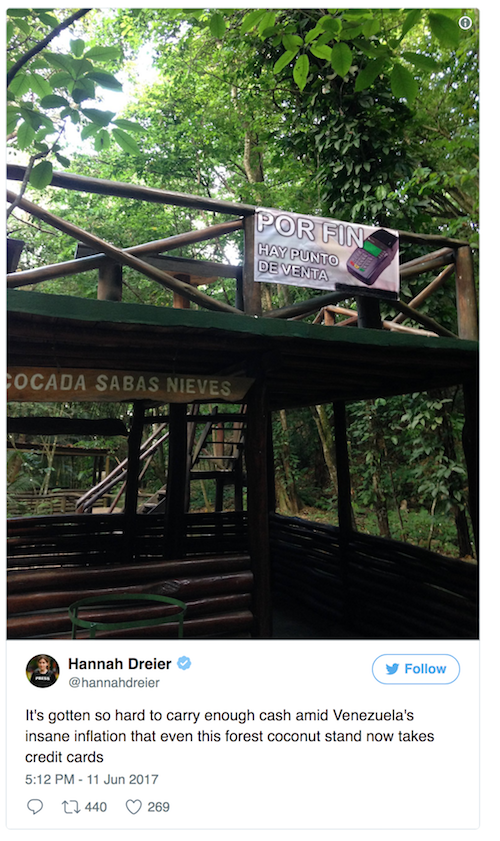
These days, Venezuela is in the international headlines almost daily: food shortages, spreading hunger, people dying for lack of medicine, and soaring homicide rates.
Citizens demonstrate their discontent in the streets every day with blood, sweat and tears, as Nicolás Maduro’s increasingly unconstitutional regime clings to power.
How is this possible, economically speaking? How can an economy that was thriving until 2012 lose a third of its GDP in five years and now be dangerously close to defaulting on its foreign debt?
This dizzying descent into insolvency has stirred up an international ruckus, prompting the investment firm Goldman Sachs to – controversially – buy up US$2.8 billion in bonds from Maduro’s cash-strapped government.
The crisis, Part I
Venezuela’s crisis is deep and complex, comparable, perhaps, only to the era of wars in the 19th and 20th centuries, when a series of military dictatorships from 1830 to 1935 caused widespread hunger and political instability, undermining confidence in Venezuela both at home and abroad.
But the current crisis did not begin then, nor did it start during the Chávez regime, as many believe.
Chaos has in fact been brewing here since the early 1970s. Once an exemplar of economic growth, largely thanks to the oil industry, Venezuela saw its per capita gross domestic product (GDP) grow 250% between 1958 and 1977, according to figures from the Venezuelan Central Bank.
Starting after the death of military strongman Juan Vicente Gómez in 1935 and continuing through the administration of president Carlos Andrés Pérez (1974-1979), Venezuela had very low inflation, a strong currency and an urbanization process that was renowned worldwide.
It was hailed as a beacon of democracy for the Americas.
Most of this was, alas, a mirage. By the mid-1970s, president Pérez’s nationalization of the Venezuelan oil industry would reveal the fragility of an economy heavily dependent on a single resource – and one rather poorly managed.
Figure 1: Gross domestic product per capita (in Venezuelan bolivares, 1997 value)

Venezuela Central Bank/Econometrica IE, SA, Author provided
By the end of the decade, the “illusion of harmony” had faded, replaced by a long period of economic instability.
Inflation soared, rising from 7.2% in 1978 to 81% in 1989, significantly undermining Venezuelans’ purchasing power and making exports and imports extremely volatile.
A foreign debt crunch was also brewing, and by the early 1980s it had reached crisis proportions.
Between 1983 and 1988, the consecutive administrations first of president Luis Herrera Campins and president Jaime Lusinchi, tried to stabilize the currency by imposing price controls and foreign exchange controls. These efforts proved fruitless.
This economic meltdown was accompanied by a broad-ranging social and political crisis, including, in 1989, the chaotic protests of February 27 and 28 (during which somewhere between 300 and 1,000 people died) and, in 1992, a coup d’etat again president Carlos Andrés Pérez, then in his second term of office.
This move, which was criticized as mere appeasement, came at a terrible time: the president was ousted just when he was introducing significant political and economic reforms. As a result, they were never implemented. And if the economy eventually stabilized, its fundamentals haven’t quite been right since.
“Saudi Venezuela”
Venezuelans seem to have retained a historical memory of the early-1970s salad days. Is it possible we still do not understand that such abundance was illusory, impossible and unsustainable?
These social and historical grievances were the stepping stone for Hugo Chávez to win the presidency in 1998 with 56.2% of votes. The left-wing former army commander took power with the clear intention of reshaping the country in his image and promises of helping lift poor Venezuelans out of poverty.
Chávez’s plan to implement structural reforms of the Venezuelan state included the drafting, in 1999, of a new constitution, and the 2003 takeover of the nation’s leading foreign exchange earner, Petróleos de Venezuela, SA, then Latin America’s biggest oil company.
Against the voracious advances of Chávez, who in April 2002 was briefly deposed by high-ranking military officers, a steady stream of protests emerged.
In 2003, a general strike halted oil production and most business operations in the country for two-and-a-half months, culminating in the 2004 presidential recall referendum, which Chávez won.
The president’s good fortunes were buoyed by an unparalleled boom in international oil prices. This enabled Chávez to tighten his grip on power by implementing aggressive anti-poverty programs, called Bolivarian Missions, including housing subsidies, adult-education campaigns and discounted food.
The oil boom petered out in 2014, but Chávez remained bullish, eagerly issuing debt papers on international markets and bilaterally, with China, ratcheting foreign debt up from US$25 billion in 2005 to over US$120 billion by 2006.
Most of these funds fuelled a spending spree comparable only to that of the late-1970s “Saudi Venezuela” period.
Unviable nation
While Chávez’s 21st-Century Socialism model seemed to be thriving, the president was quietly and dangerously taking over Venezuela’s democratic institutions. Open supporters of Chavismo were appointed judges, prosecutors and election officials, contravening Venezuela’s 1999 Constitution.
His winning streak ended abruptly and disastrously when Chávez died of cancer just a few months after his reelection in 2012. His legacy: a government that spent more than it made, even when oil prices remained high at US$100 a barrel.
In April 2013, Chávez’s appointed successor Nicolás Maduro eked into the presidency with a 1.5% margin, swearing to accept the position “for Christ the Redeemer, in Him and through Him, for the people of Venezuela and in eternal memory of the Supreme Commander Hugo Chávez”.
Evidently, the system-wide bankruptcy brought on by Chavismo was not yet apparent to about 50% of the electorate. But reality soon set in: in early 2014, Venezuela slipped into recession.
Maduro proved unable to implement the political and economic corrections needed to stabilize the nation. His paralysis proved devastating: per capita supplies of goods and services went down by 40% between late 2013 and 2014.
Figure 2: Per capita supply of goods and services (in Venezuela bolivares, 1997 value)

Venezuelan Central Bank/Econometrica IE, SA, Author provided
In 2014, international oil prices began their plunge, dropping from a peak of US$115 per barrel in June 2014 to US$35 by February 2016. Inflation reached 800%.
Venezuela’s democratic institutions, weakened by Chavismo, lacked the capacity to respond to the economic crisis, deepening the country’s woes and leaving it in the unviable situation it faces today. There’s not enough food, money or safety to go around.
 After more than four decades of a dizzying economic ups and downs, Venezuelans are finally understanding just how ineffective central planning has been.
After more than four decades of a dizzying economic ups and downs, Venezuelans are finally understanding just how ineffective central planning has been.
Rebuilding the nation will require fundamentally rewriting the rules of the game. That means reconstructing both the Venezuelan economy, by shifting it towards a market economy, and Venezuelan institutions, by reweaving the economic and political fabric back together.
Ending the current economic paralysis will take a multi-sectoral pact in which academics, political parties, trade unions, business associations, churches, universities and businessmen, among others, agree, at least minimally, on a plan for the future.
![]() They must also work together to garner public support so that Venezuelans – unified – can dismantle the “patrimonialist state” that has caused, and keeps on causing, so much anguish.
They must also work together to garner public support so that Venezuelans – unified – can dismantle the “patrimonialist state” that has caused, and keeps on causing, so much anguish.
Henkel Garcia U, Finance Instructor, Professional Studies Extension Program, Andres Bello Catholic University (UCAB)
This article was originally published on The Conversation. Read the original article.

